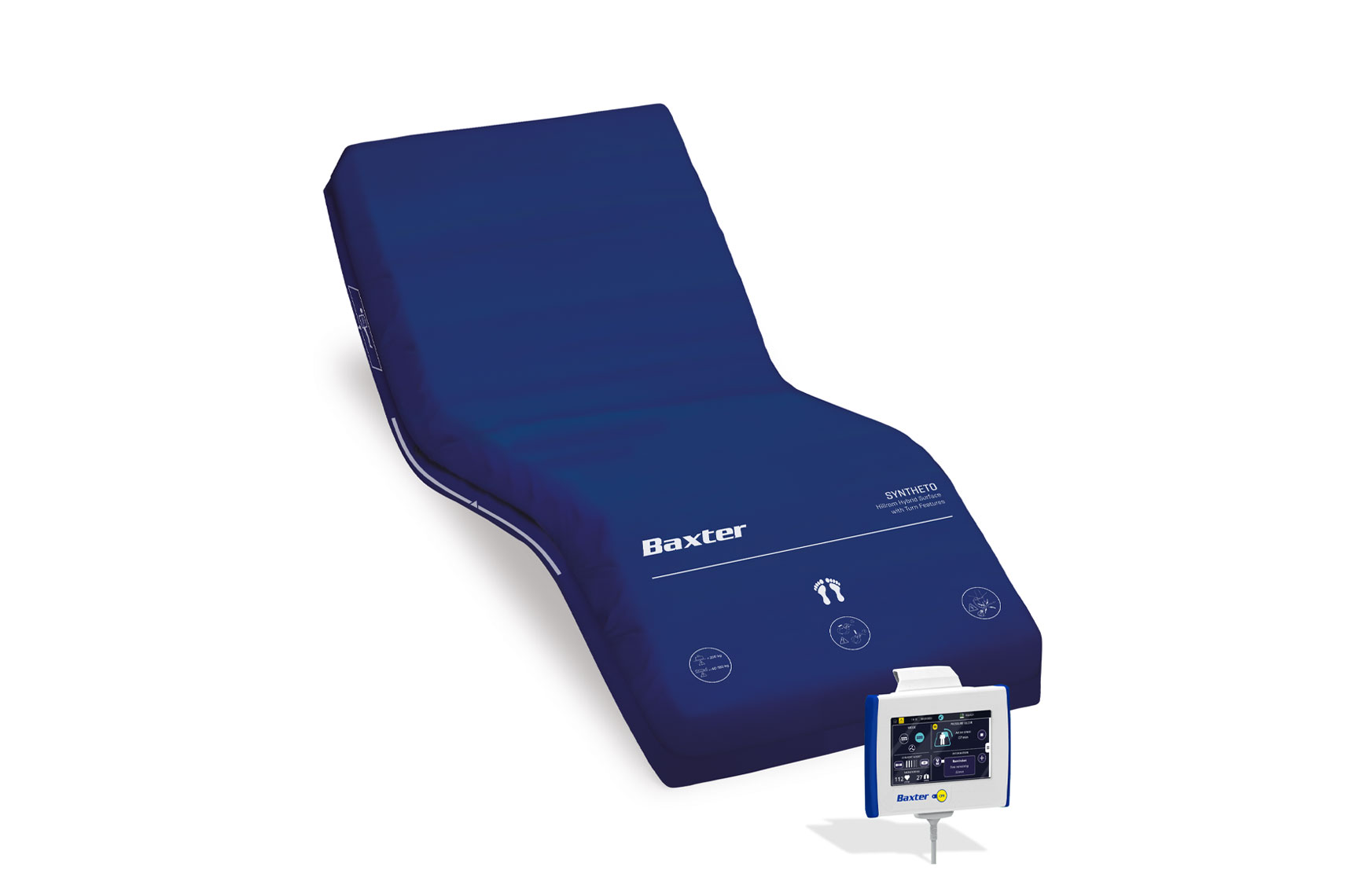The Future of Support Surfaces
Watch the video to discover our THERAPY2 and SYNTHETO Surfaces.
Hospital mattresses serve as a critical solution that supports patient comfort, clinical outcomes and operational pressures. They can play a significant role in the quality of care, caregiver satisfaction and the patient experience.
We offer a comprehensive solution for hospital mattresses so you can treat your patients with confidence starting with the proper surface.
Meet Our THERAPY2 and SYNTHETO Surfaces
More Than Just Surfaces
Today’s Challenges
Constant change and increased complexity in healthcare requires a comprehensive surface solution to address your challenges:
Some Key Factors to Consider When Choosing Surfaces for Your Facility:

Preventing Pressure Ulcers:
Protect Patient Health and Comfort
- The median prevalence of Pressure Ulcers (PU) in Europe is 10.8%.1
- A PU can develop in less than one hour.2
- Choose flexible surfaces that are ready to support specialized therapies if complications arise.

Preventing Healthcare Workers' Injuries:
Enhance Staff Well-being and Productivity
- 47% of the workers in human health and social work activities experienced back pain and 46% experienced upper limb pain.3
- Repositioning patients in bed is one of the most common patient handling activities and is associated with musculoskeletal disorders in healthcare workers.4
- With smart surfaces with Mobilization Mode your facility can achieve up to 36% reduction in effort required to turn patients.5

Minimizing Operational Burden:
Streamline Hospital Workflows and Resources
- The healthcare worker shortage in Europe in 2013 was 1,6 million and the projection by 2030 is 4,1 million.6
- The time spent per nurse to document and complete forms at the bedside is 4 hours/day.7
- Connectivity features in surfaces and the flexibility to adapt to different patients' conditions can help improve caregivers' efficiency.

Financing Smart Surfaces:
Maximize Budget Efficiency and Sustainability
- Underinvestment in health systems is one key challenge that Europe is facing in keeping its health systems afloat.8
- The pandemic has accelerated hospital adoption of digital technologies9, but these investments are often limited by tight capital equipment budgets.
- Hospitals are exploring alternative financing options, such as leasing agreements for smart surface adoption.
BAXTER CAN SUPPORT

PREVENT
Increase turn engagement10, 11 and provide patient lateral mobilization through the functionalities of Syntheto and Therapy2 surfaces.

OBSERVE
Continuously measure patient Heart Rate and Respiratory Rate* to alert to physiological indicators of a patient’s condition.12 Stay connected to be informed on patient exit, surface mode and reminders, where and when you need it.

REACT
Quickly switch to a dynamic air therapy surface mode as soon as the patient skin deteriorates, because a pressure injury can develop in less than one hour.2

TREAT
Use our advanced skin protection therapy modes that can assist in the treatment of pulmonary complications associated with patient's immobility.13, 14
*Optional feature. Please check availability with your local Baxter representative.
The Baxter Surfaces Collection
Find the best hospital mattresses/surfaces within our portfolio to address your needs. Because proper care begins with the proper surface, for your patients and for your team.
This site is intended for Healthcare Professionals.
Manufacturer: Hill-Rom S.A.S. - Z.I. du Talhouët 56330 Pluvigner, France
Class IIa - Notified Body GMED 0459
These medical devices are regulated health product which, pursuant to such regulation bears a CE mark. Baxter recommends that you carefully read the detailled instructions for safe and proper use included in the documents accompanying the medical devices. The personnel of healthcare establishments are responsible for the proper use and maintenance of these medical devices.
References:
1. Moore, Zena et al. “The prevalence of pressure ulcers in Europe, what does the European data tell us: a systematic review.” Journal of wound care vol. 28,11 (2019): 710-719
2. Gefen, Amit. “How much time does it take to get a pressure ulcer? Integrated evidence from human, animal, and in vitro studies.” Ostomy/wound management vol. 54,10 (2008): 26-8, 30-5.
3. European Agency for Safety and Health at Work. Discussion Paper: Musculoskeletal Disorders in the Healthcare Sector. European Agency for Safety and Health at Work, 2023.
4. Zhou, Jie, and Neal Wiggermann. “The effects of hospital bed features on physical stresses on caregivers when repositioning patients in bed.” Applied ergonomics vol. 90 (2021): 103259.
5. Wiggermann, Neal. “Biomechanical Evaluation of a Bed Feature to Assist in Turning and Laterally Repositioning Patients.” Human factors vol. 58,5 (2016): 748-57.
6. Zapata, T., Azzopardi Muscat, N., Falkenbach, M., & Wismar, M. (2023). From great attrition to great attraction: Countering the great resignation of health and care workers. Eurohealth - Journal of the European Observatory on Health Systems and Policies, 29(1), 6-10.
7. Penoyer, Daleen Aragon et al. “Use of electronic health record documentation by healthcare workers in an acute care hospital system.” Journal of healthcare management / American College of Healthcare Executives vol. 59,2 (2014): 130-44.
8. Health Policy Watch. "Europe struggles to keep health systems afloat." Health Policy Watch, 26 Sep. 2023.
9. Negreiro, Mar. The rise of digital health technologies during the pandemic. European Parliament Briefing, PE 690.548 – April 2021
10. Schutt, Suann Cirigliano et al. “Pilot study: Assessing the effect of continual position monitoring technology on compliance with patient turning protocols.” Nursing open vol. 5,1 21-28. 26 Oct. 2017.
11. Internal Hillrom Summative Usability Test Report, PRJ01060 ISE, NPD45119.
12. Kayser, Susan A et al. “Respiratory rate monitoring and early detection of deterioration practices.” British journal of nursing (Mark Allen Publishing) vol. 32,13 (2023): 620-627.
13. Swadener-Culpepper, Leslie et al. “The impact of continuous lateral rotation therapy in overall clinical and financial outcomes of critically ill patients.” Critical care nursing quarterly vol. 31,3 (2008): 270-9.
14. Goldhill, David R et al. “Rotational bed therapy to prevent and treat respiratory complications: a review and meta-analysis.” American journal of critical care: an official publication, American Association of Critical-Care Nurses vol. 16,1 (2007): 50-61.
EMA-CS394-240012 (v2.0) 04/2025


















